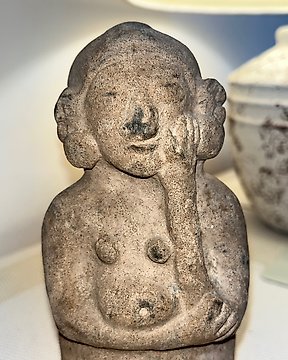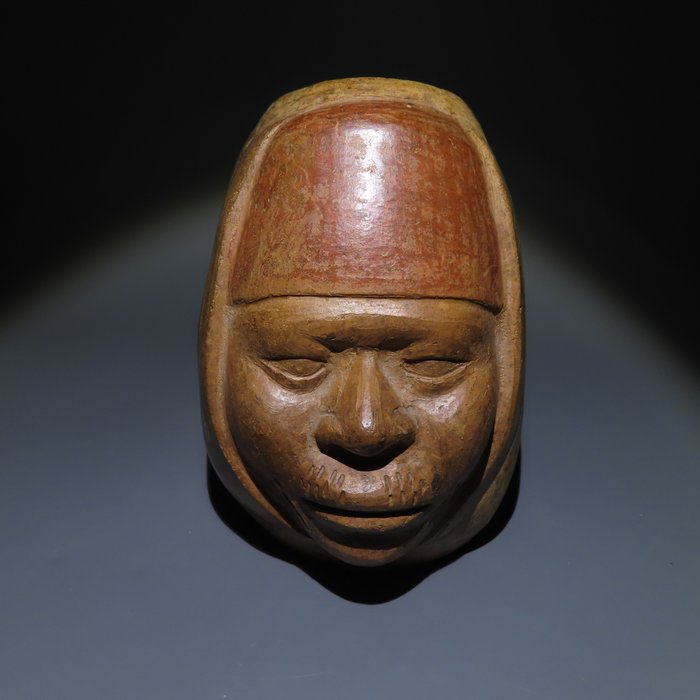
图马科-托利塔 Terracotta 孕妇的思考位置 - 23 cm
编号 82642445

编号 82642445

Huaco in the shape of a human head.
Moche, Perú.
200-600 AD.
Terracotta
Height 16 cm
PROVENANCE: Private collection Boeckman, Dallas, United States. Acquired on May 4, 1970 from the Denver Art Museum, formerly May's private collection, St. Louis, United States. With spanish export license.
CONDITION: Good condition, only a griet in the back part.
DESCRIPTION:
Huacos are closed vessels with a spherical or sculpted body, a flat base and a tubular handle in the form of a stirrup. They have been and are one of the principal elements which allow us to know not only characteristics of this pre-Hispanic culture, but also of its society, the natural environment in which it developed and the different stages of its cultural evolution. Its name derives from huaca, the name referring to a tomb of this culture, as moreover, these vessels were destined to make up part of the grave goods of a deceased person.
The Moche culture inhabited the coast of present-day northern Peru, concentrating in the valleys of Lambayeque, Chicama, Moche and Virú. This desert region is crossed by several rivers that flow down into the Pacific Ocean, where marine resources are plentiful.
The Moche people began as an agricultural-maritime culture, but after expanding into inland territories they focused more on farming and herding. They channeled river water to irrigate their extensive crops, which included cotton, maize, peanuts and beans. They raised herds of llama and domesticated dogs and guinea pigs. From the seacoast they obtained marine resources for their own use and for trading with groups from the interior. All of these activities generated surplus goods that were stored in silos and granaries that were administered by Moche authorities.
The Moche produced fine ceramic, textile and precious metal pieces. Their characteristic style can be seen in a wide range of goods such as fire-engraved gourds, wall murals, featherwork art, body painting and tattoos. Their ceramic decoration displays a level of skill that has rarely been surpassed, and included such techniques as incision, bas-relief with stamps, and painting on smooth surfaces. Many were made in state-run workshops that mass-produced pieces from molds. Their ceramics came in a variety of forms and decorative styles and displayed myths and ritual motifs as well. Notable among these earthenware forms were the so-called “portrait bottles”, bottles molded with the face of a well-known Moche figure. These highly detailed facial portraits reflect the Moche’s own use of face paint and/or tattoos, as well as elaborate headdresses. This portrait-making expertise can also be observed in everyday scenes and erotic representations, as well as in figures of individuals that were hunch backed, blind, or suffered from other disorders. They were skillful metalworkers, using gold, copper and silver to make ear ornaments, nose rings, bracelets, necklace beads, tweezers and a variety of tools. Especially notable is the tumi or ceremonial knife that was usually only carried by Moche officials.
At its zenith, the Moche culture appears to have been organized into two independent states that controlled the north and south regions, respectively. Both of these were extremely hierarchical societies in which warriors held a high rank. In fact, the highest political position in Moche society seems to have been occupied by a warrior-priest figure, who was represented frequently in Moche art. Beneath this official were several different social classes, including artisans, merchants, peasants, herders and fishermen. Prisoners of war comprised yet another social class in Moche society, and were treated as slaves and often sacrificed to honor the gods.
Moche ceramics provide detailed representations of the culture’s supernatural world, including deities, myths, sacred animals and ceremonial practices. Their deities take the form of foxes, owls, hummingbirds, falcons and felines. These figures were servants of greater gods that had human form and sported elaborate outfits and ferocious faces with crossed fangs.
Tombs of important Moche individuals were rectangular and made of adobe, with niches for offerings. Some bodies were laid on cane mats, while others were left in caves inside cane coffins. People of the elite class were buried with metal masks and a rich array of grave goods, servants and animals accompanying them. The famous “Lord of Sipán” is the most notable example of this kind of burial.
Many of the motifs adorning early Moche ceramics were derived from the Recuay culture. These two peoples were certainly in contact, as all of the irrigation waters the Moche used in their valleys flowed down from Recuay territory. In the early years, the Moche also had contact with groups of the Salinar and Gallinazo cultures. It is very likely that the Moche disappeared when they were overtaken by the Wari Empire, but their civilization also suffered from long periods of flooding by the El Niño phenomenon, which would have destroyed their farming infrastructure and could have helped precipitate their collapse. The final stage of the Moche culture displays features that would later appear in the Chimú culture.
Notes:
- The piece includes authenticity certificate.
- The piece includes Spanish Export License.
- The seller guarantees that he acquired this piece according to all national and international laws related to the ownership of cultural property. Provenance statement seen by Catawiki.
THE MINISTRY OF CULTURE FROM SPAIN ASKS ALL SELLERS FOR INVOICES, IMPORT LICENSES AND ALL THE DOCUMENTATION ABLE TO PROVE THE LEGALITY OF EACH ITEM BEFORE PROVIDING AN IMPORT OR EXPORT LICENSE.
#ExclusiveJurassicAntiquity